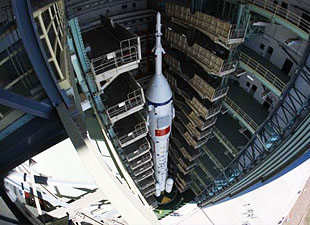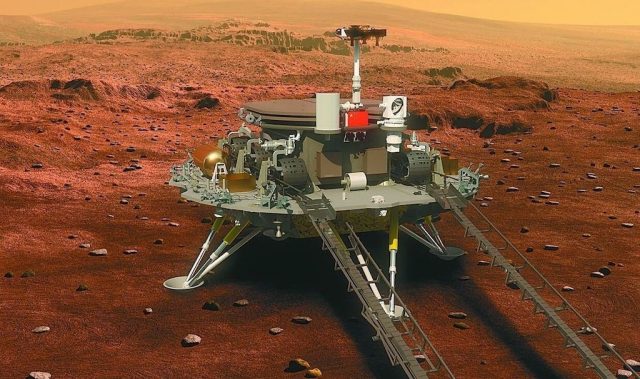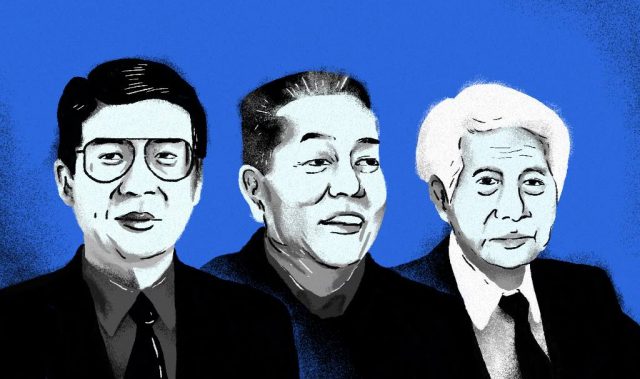
AsianScientist (Jun. 22, 2012) – Blasting into the history books this week, China became the third country after the United States and Russia to dock a spacecraft with an orbiting space station — an achievement made all the more notable because aboard that craft was Liu Yang, China’s first woman astronaut.
On June 16, China’s Long March 2F two-stage rocket carrying the Shenzhou-9 spacecraft lifted off from the Jiuquan launch centre in the Gobi desert. The launch was broadcast live on Chinese state television. Two days later, Shenzhou-9 successfully docked with the Tiangong-1 space laboratory.
But by far the bigger story is China’s discovery of a new star — in the form of Liu, the country’s first woman spacefarer.
Just a couple of days before the launch, like any good reality TV show, Chinese space enthusiasts were left guessing as to which of the two shortlisted women astronauts would be selected for the Shenzhou-9 mission.
Both Liu Yang and her unsuccessful rival Wang Yaping are advanced fighter pilots in their 30s. They were vying for a slot among three mission astronauts, which would eventually consist of two men and one woman.
Liu Yang, a 33-year-old Air Force major from Henan province, was finally selected for the historic mission. Liu’s role on the spacecraft will be to improve the working efficiency of the crew and carry out medical experiments.
“Generally speaking, female astronauts have better durability, psychological stability and ability to deal with loneliness,” said a spokeswoman of China’s manned space programme a day before the launch.
According to the official Xinhua news agency, Liu joined the People’s Liberation Army Air Force in 1997 and became a veteran pilot after flying for 1,680 hours without incident. She was recruited as a prospective astronaut in May 2010 and selected in March of this year to possibly crew the Shenzhou-9.
Besides Liu, the two other crew members are mission commander Jing Haipeng, 46, and flight engineer Liu Wang, 42.
Liu’s maiden flight comes 49 years after Russian cosmonaut Valentina Tereshkova’s 1963 Vostok 6 mission, a launch that made Tereshkova the first woman in space.
The space lab Tiangong-1 (which means Heavenly Palace) was launched in September 2011 as a prelude to the Tiangong-2 and -3 space labs and a full space station in 2020.
In December last year, the Chinese government announced its five-year plan for space exploration in its white paper China’s Space Activities 2011. Long-term goals include the collection of samples from the Moon by 2016 and bringing online its three-man crew space station by 2020, around the time when the 17-nation International Space Station is due to be deactivated.
But it also plans to explore and utilise “outer space for peaceful purposes”, the white paper says, emphasising that “each and every country in the world enjoys equal rights to freely explore, develop and utilise outer space and its celestial bodies”.
These goals were reiterated by China’s permanent representative to the United Nations, Cheng Jingye, at the 55th session of the UN committee on the peaceful uses of outer space in Vienna earlier this month.
Cheng said that China is willing to cooperate with other countries and provide opportunities for more countries — particularly developing nations — in the construction of the Chinese space station.
Saturday’s launch and the Tiangong space station project are part of China’s ambitious human space flight programme, codenamed Project 921, which began in 1999 and incorporates a number of Russian technologies.
The project places much emphasis on lunar missions, with the ultimate aim of a manned Moon landing around 2030. Its lunar missions are named after the Chinese goddess of the moon, Chang’e, and the first such mission in 2007 helped to create an accurate and a high-resolution map of the Moon’s surface. Chang’e-5 is slated to carry lunar rocks back to the Earth in 2017.
China has also set its sights on Mars. Its space scientists are already preparing for the country’s first unmanned Mars exploration mission between 2014 and 2033, and possibly even a manned landing on Mars sometime between 2040 and 2060.
Just last year, one of China’s astronauts, Wang Yue, was subjected to a gruelling 520-day study to test the endurance and psychological limits of a human being on a mission to Mars. The Mars500 project simulated a human mission to Mars at a facility outside Moscow, with Wang holed up in a capsule for a year and a half with Russian, Italian, and French colleagues.
Although China is a late entrant to human space flight, compared to the United States and Russia, the country has laid out a clear trajectory to reach its space targets. Space experts agree that China has made major breakthroughs in homegrown space technology in a relatively short time.
China’s efforts may pose a challenge to the established missions of US and European space programmes. With the National Aeronautics and Space Administration’s (NASA) human space flight programme in limbo because of politics and budgets, China has the potential to become a world leader in this field — a move that may not only have political and scientific value, but also military significance.
But for now, the world is rooting for Liu Yang, whose space fairytale is an inspiration for many.
“When I was a pilot, I flew in the sky. Now that I am an astronaut, I will fly in space. This will be a much higher and farther flight,” said Liu, whose future celebrity status seems written in the stars.
——
Copyright: Asian Scientist Magazine.
Disclaimer: This article does not necessarily reflect the views of AsianScientist or its staff.












